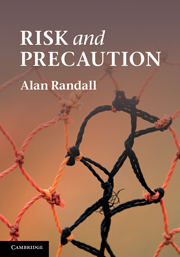Book contents
- Frontmatter
- Contents
- List of figures
- List of boxes
- Authors cited
- Acknowledgements
- List of acronyms
- Part I The precautionary principle – why so much fuss about such a simple idea?
- Part II Harm and chance – managing risk
- Part III Defining and justifying a coherent precautionary principle
- 6 A defensible precautionary principle must withstand these challenges
- 7 Toward a precautionary principle framework: evidence, threat, and remedy
- 8 Threat and evidence
- 9 Remedy
- 10 Precaution for utilitarians?
- 11 A robust and defensible precautionary principle
- Part IV Precaution in action
- Part V Conclusion
- References
- Index
10 - Precaution for utilitarians?
Published online by Cambridge University Press: 05 June 2012
- Frontmatter
- Contents
- List of figures
- List of boxes
- Authors cited
- Acknowledgements
- List of acronyms
- Part I The precautionary principle – why so much fuss about such a simple idea?
- Part II Harm and chance – managing risk
- Part III Defining and justifying a coherent precautionary principle
- 6 A defensible precautionary principle must withstand these challenges
- 7 Toward a precautionary principle framework: evidence, threat, and remedy
- 8 Threat and evidence
- 9 Remedy
- 10 Precaution for utilitarians?
- 11 A robust and defensible precautionary principle
- Part IV Precaution in action
- Part V Conclusion
- References
- Index
Summary
The precautionary principle developed in Chapters 7 – 9 departs from ordinary risk management in several ways. It is more likely to prohibit a proposed novel intervention when faced with a specific NI1 that presents a disproportionate threat; and it is more likely to prescribe a pre-release testing regime for a whole class of NI1 innovations if some of its members have presented disproportionate threats in the past (e.g. new drugs, synthetic chemicals), or theory and/or experience suggest that the class has the capacity to generate some disproportionate threats (e.g. some groups of genetically modified organisms). Radically new technologies that present plausible scenarios of disproportionate harm but no basis for specifying its likelihood are obvious candidates for pre-release testing. Note that if the NI1 can be quarantined, prohibition readily defaults to the quarantine and stepwise release process, which begins with pre-release testing, and can be discontinued at any time if it is determined that no serious threat exists. When a general release is approved, the precautionary principle (PP) is more likely than ordinary risk management (ORM) to prescribe rigorous post-release surveillance, and likely remedies should a serious threat be confirmed include withdrawal from the market and remediation of damage.
For novel interventions ex post and overstress from business-as-usual (BAU), the PP is likely to prescribe early warning systems and prompt remedial action should the alarm be signaled. For both NI2 and BAU cases, remedies may include an important role for adaptive management.
- Type
- Chapter
- Information
- Risk and Precaution , pp. 172 - 183Publisher: Cambridge University PressPrint publication year: 2011



